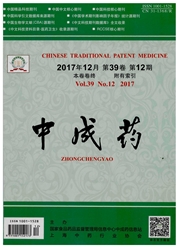

 中文摘要:
中文摘要:
目的采用HPLC法比较巴戟天不同炮制品中1,2-二甲氧基-3-羟基蒽醌、1-甲氧基-2-羟基蒽醌、1,3-二羟基-2-甲氧基蒽醌、甲基异茜草素-1-甲醚、甲基异茜草素的含有量。方法巴戟天炮制品以三氯甲烷提取,使用Thermo Syncronis C18色谱柱(150 mm×4.6 mm,5 mm),流动相为乙腈-0.2%磷酸水,梯度洗脱,检测波长277 nm。结果5种成分分别在7.1~57.1 mg/L、8.2~65.4 mg/L、8.6~345 mg/L、3.1~124.8 mg/L、1.3~50.8 mg/L范围内线性关系良好,r2分别是1.000、1.000、1.000、0.999、0.999,加样回收率分别为102.6%、95.2%、99.7%、103.8%、103.0%,RSD分别为1.2%、0.8%、1.4%、1.3%、2.2%。结论与生品相比,巴戟肉(蒸去心)、盐蒸巴戟、甘草水煮巴戟天中5种蒽醌的含有量有不同程度的增加。
 英文摘要:
英文摘要:
AIM To compare the effects of processing methods on the contents of alizarin anthraquinones (in- eluding 1-methoxy-2-hydroxy anthraquinone, 1,2-dimethoxy anthraquinone, rubiadin-l-methyl ether, 1,3-dihydroxy anthraquinone, and rubiadin) from Bajitian (Morindae officinalis Radix). METHODS The analysis of Bajitian chloroform extract was performed on Thermo Syncronis C18 column (4. 6 mm× 150 μm, 5 μm) with acetonitrile- phosphoric acid water as mobil phase in a gradient elution mode, and the detection wavelength was set at 277 nm. RESULTS The calibration curves were linear in the range 7. 1-57. 1 mg/L for 1-methoxy-2-hydroxy anthraquinone (r = 1.000), 8. 2 -65.4 mg/L for 1,2-dimethoxy anthraquinone (r = 1. 000), 8. 6 -345 mg/L for rubiadin-l-meth- yl ether (r = 1. 000), 3. 1 - 124. 8 mg/L for 1,3-dihydroxy anthraquinone (r =0. 999 9), and 1.3 -50. 8 mg/Lfor rubiadin (r = 0. 999 5 ), respectively. Their average recoveries were 102. 6% , 95.2% , 99.7% , 103.8% , and 103.0% , respectively. Their RSDs were 1.2% , 0. 8% , 1.4% , 1.3% , and 2. 2% , respectively. CONCLUSION As compared with raw Bajitian, processing makes five anthraquinones contents increase in Bajitian, which compose steaming-and-remove-xylem, processing with salt-water, and coboiling with Gancao.
 同期刊论文项目
同期刊论文项目
 同项目期刊论文
同项目期刊论文
 期刊信息
期刊信息
